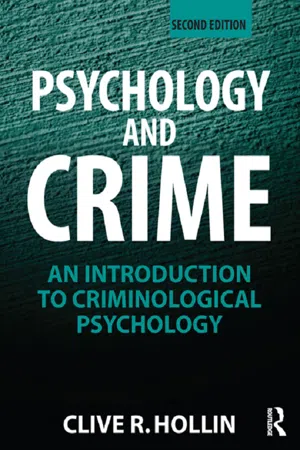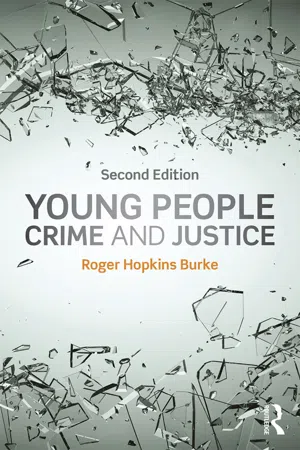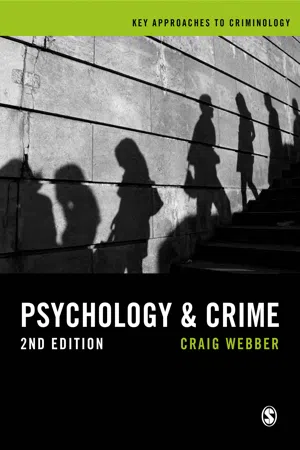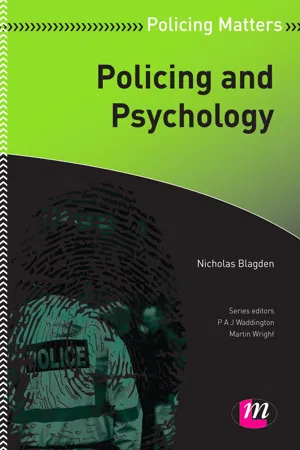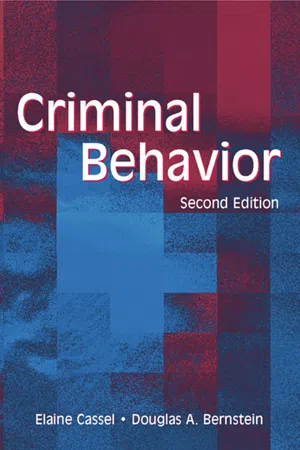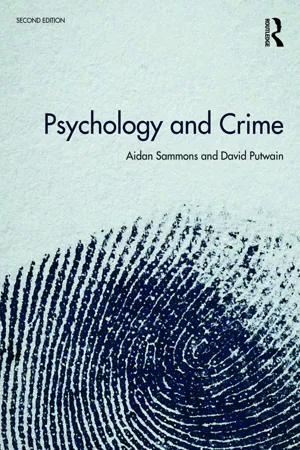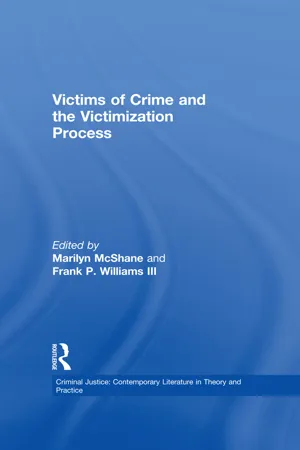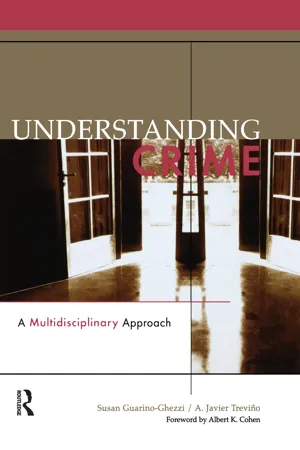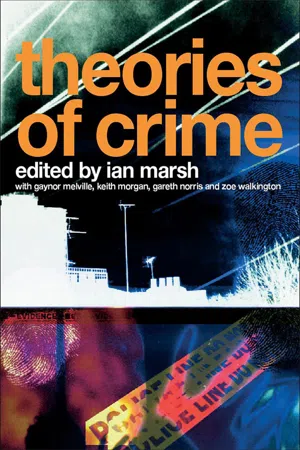Psychology
Psychological Theories of Crime
Psychological theories of crime seek to understand the underlying psychological factors that contribute to criminal behavior. These theories explore how individual differences in personality, cognition, and emotions may influence criminal tendencies. They also examine the impact of environmental and social factors on the development of criminal behavior, aiming to provide insights into the prevention and treatment of criminal conduct.
Written by Perlego with AI-assistance
Related key terms
11 Key excerpts on "Psychological Theories of Crime"
- eBook - ePub
- Helen Gavin(Author)
- 2018(Publication Date)
- SAGE Publications Ltd(Publisher)
3 Psychological Approaches to Understanding CrimeKey Themes
- Biosocial theories of crime
- Social learning theory and crime
- Psychodynamic theories of crime
- Evolutionary models of crime
- Feminist models of crime
In many sciences, there are attempts being made to find a unified theory, so far, unsuccessfully. Even in a discipline such as physics, the concept of a unified theory has a seemingly insurmountable barrier to overcome in that two compellingly explanatory theories (general relativity and quantum theory) are totally incompatible. So, it is hardly surprising that the study of mind and behaviour is no exception to such a quest, or such difficulties. The study of crime is no stranger to this desire to discover a global explanation, but we remain with the position of several different perspectives attempting to provide understanding of criminal behaviour within existing psychological frameworks. Psychological explanations of crime suggest that individual differences may make it more likely that some people commit crimes than others. These differences may be due to personality characteristics, biological factors, or social influences. There is therefore a hierarchical set of different perspectives, from the social to the individual, that are useful in understanding the nature of crime and the theories attempting to explain it.Strain theory – social structures exert pressures which may lead an individual to commit crime.Crime and the Role of Society
Social theories suggest that crime is an outcome of the breakdown in social structures. This can be either at a structural level, where societal processes affect members of society, or at an individual level, where the experiences of people as they seek ways to satisfy their needs are examined. The first major theorist in this area was Merton, whose 1938 analysis of the relationship between society and the values and behaviour of members of that society was pivotal in the sociological examination of crime. The resultant theoretical perspective, strain theory, is an attempt to explain crime via the pressures that society and societal goals can exert. Hence, unemployment, inequity, abuse of power, and other macro-level issues are direct influences on crime and the causes of crime. Violence may occur as a result of harassment, stealing may be to resolve financial problems. Agnew (1992, 2009) updated the theory to account for different types of strain, such as that resulting from society preventing the achievement of goals, and the strain occurring when in receipt of negative or noxious stimuli, such as the theft of valued items, or anger against the individual. Agnew termed this a general strain theory, attempting to describe the ways in which strain impacts in society and particularly on young people. He suggested several characteristics of strain that might lead to crime, that it is: - eBook - ePub
Psychology and Crime
An Introduction to Criminological Psychology
- Clive R. Hollin(Author)
- 2013(Publication Date)
- Routledge(Publisher)
3 Psychological theories applied to crime
In this chapter, the focus is on the way in which psychological theories have been applied to formulate an understanding of criminal behaviour. In order to help appreciate the way in psychological theories have unfolded over time, the various theories are shown in chronological order in Box 3.1 . It should be said that this way of presenting the flow of theory gives a rather neat appearance to what is, in truth, a far from precise process. Theories do not start and stop at exact dates and their development may be traced to an interaction between historical period and the personal characteristics of the theoretician (Simonton, 2002). There is often a period of time, during which the empirical evidence accumulates and the associated academic debate take place, before the full exposition of a given theory. Further, there is not an exact point at which a favoured theory is universally abandoned for another theory. Indeed, most of the theories discussed below, from the earliest to the most recent, are still alive and well, although sometimes in a different form to which they first appeared.It is also the case, within and across disciplines, that not every researcher and practitioner holds the same theoretical views. In different disciplines there may be diverse means by which a theory changes and develops. Thus, contemporary psychology relies heavily on scientific method and empirical evidence as the means by which to advance theory. In philosophy, on the other hand, the picture is different, as described by Russell:Philosophy, as I shall try to understand the word, is something intermediate between theology and science. Like theology it consists of speculations on matters as to which definite knowledge has, so far, been unascertainable; but like science, it appeals to human reason rather than authority … between theology and science there is a No Man’s Land, exposed to attack from both sides; this No Man’s Land is philosophy. - eBook - ePub
- Roger Hopkins Burke(Author)
- 2016(Publication Date)
- Routledge(Publisher)
9 Psychological explanations of youth crime
DOI: 10.4324/9781315773100-9Key issues- Psychodynamic theories
- Behavioural learning theories
- Cognitive learning theories
- Conclusions
Psychological explanations of offending behaviour direct our attention to the mind of the individual and it is here that we encounter notions of the ‘criminal mind’ or ‘personality’. For purist advocates of the psychological variant of the predestined actor model – or psychological positivists – there are patterns of reasoning and behaviour that are specific to offenders and these remain constant regardless of their different social experiences. There are three broad categories of Psychological Theories of Crimes and while the first two groupings, psychodynamic and behavioural learning theories, have firm roots in the predestined actor tradition, the third group, cognitive learning theories, reject much of the positivist tradition and, in their incorporation of notions of creative thinking and, thus, choice are, in many ways, more akin to the rational actor model of criminal behaviour. Each tradition, nevertheless, proposes that the personality is developed during the early formative childhood years of the individual through a process of learning, much of which is subconscious.Psychodynamic theories
Psychodynamic explanations of criminal behaviour have their origins in the extremely influential work of Sigmund Freud (1856–1939) and his theories about how our personalities develop as an outcome of our intimate relationships – or lack of these – with our parents and, in particular, our mother. His assertion that sexuality is present from birth and has a subsequent course of development is the fundamental basis of psychoanalysis and it is one that has aroused a great deal of controversy. Freud had originally proposed that it was the experience of sexual abuse in childhood that is the basis of all neurosis, but he subsequently changed his mind: the abuse had not actually taken place but was merely fantasy. It is this notion of the repressed fantasy that is the core tenet of the psychoanalytic tradition. - eBook - ePub
Psychology and Crime
A Transdisciplinary Perspective
- Craig Webber(Author)
- 2019(Publication Date)
- SAGE Publications Ltd(Publisher)
2 Psychological Perspectives on Crime Overview Moving on from a historical overview of social scientific understanding of crime, this chapter looks at the different psychological perspectives that constitute psychology. We will see that although they are sometimes presented as discrete areas of research, in fact there is some significant overlap between them. If we want to understand the problem of many accounts of crime, both sociological and psychological, then we can interrogate them through the lens of age. One of the key criminological truisms is that most people grow out of crime (Rutherford 1986/2002). This will be a recurring theme of this chapter so that the different psychological perspectives can be understood through issues like aging and desistance from crime. Key terms ■ Psychological Perspectives; Biological Psychology; Behaviourism; Cognitive Psychology; Psychoanalysis; Social Psychology The previous chapter explored the main approaches to understanding crime as they developed historically; this next chapter is a more in-depth overview of some of the major psychological approaches to studying human behaviour. This is not meant to be an exhaustive overview, merely a reminder for those who have already studied psychology, and an introduction for those who have not. All psychological approaches share the common focus of studying internal mental processes. Psychology can be distinguished from psychiatry through the latter’s focus on the study and treatment of mental illness and emotional disturbance. Psychiatry is a branch of medicine that, for the most part, focusses on illness and derivations from ‘normal’ 1 behaviour. Psychology is interested in a broader range of human behaviour that includes mental functions such as perception (e.g. taste, colour or object sizes), the capacity and ability of memory, as well as behaviour that some might describe as ‘abnormal’ such as aggression - eBook - ePub
- Nicholas Blagden(Author)
- 2012(Publication Date)
- Learning Matters(Publisher)
2Psychological Theories of Crime and criminal behaviour
CHAPTER OBJECTIVES
By the end of this chapter you should be able to:- understand some of the main Psychological Theories of Crime and criminal behaviour;
- apply these theories to case studies and real-world policing examples;
- think critically about Psychological Theories of Crime and their application to criminal behaviour.
LINKS TO STANDARDSThis chapter provides opportunities for links with the following Skills for Justice, National Occupational Standards (NOS) for Policing and Law Enforcement 2008.AE1 Maintain and develop your knowledge, skills and competence. HA2 Manage your own resources and professional development. HF15 Provide information to support decision making. With the introduction of the Qualification and Credit Framework (QCF), it is likely that the term ‘National Occupational Standards’ will change. At the time of writing, it is not clear what the new title will be, although it is known that some organisations will use the term ‘QCF assessment units’.Links to current NOS are provided at the start of each chapter; however, it should be noted that these are currently subject to review and it is recommended that you visit the Skills for Justice website to check the currency of all the NOS provided: www.skillsforjustice-nosfinder.com .Introduction
Why people commit crime is something that academics and practitioners have tried to explain for many years. This chapter explores some of the main psychological theories that can help explain and predict why some people commit crime and others do not. The chapter aims to provide an in-depth summary of some of the key theories, including psycho-biological, social and cognitive-behavioural approaches. Through an understanding of these theories students, particularly those pursuing careers within law enforcement agencies, will gain an insight into the many factors that influence criminal behaviour. An understanding of these theories will broaden students’ and trainee police officers’ perceptions on what (if anything concrete) causes offending behaviour. - eBook - ePub
- Robin Bryant(Author)
- 2016(Publication Date)
- Routledge(Publisher)
Although we will consider criminological and psychological perspectives separately here, there is in practice often no such clear distinction, not only in terms of arbitrary discipline division but also in terms of the application of the theory. For example, a number of psychological perspectives have clear links with the positivist school of criminology (see below), and some criminological and psychological theories clearly articulate or overlap, both between and within, the two disciplines. The US criminologist Akers argued, for example, that rational choice theory is a consequence of social learning theory, and not separate from it (Akers, 1990, cited in Blackburn, 1993, p. 109). Nor (as would also be the case with other, more conventional ‘non-digital’ crime), have we attempted to identify an all-embracing and explicative theory from within the canon of criminological theory; it is very unlikely that ‘one size’ will fit all. Instead we have identified below the criminological and psychological perspectives which appear to offer the greatest value to law enforcement. The chapter concludes with an examination of a number of specific digital crimes. We seek to identify how theory and research each illuminate the motives and methods for committing these crimes, and also suggest some ways in which theory and research inform (or might inform) their policing.Criminological Perspectives
Criminology draws upon a wide range of disciplines, for example, sociology, psychology and history. Broadly, criminological theory can be conceptualised as falling under one of three main headings or ‘Schools’:• classical/neo-classical theory (rational choice theory, routine activity theory); • positivist theory (biosocial and psychological theories, the Chicago school, social learning/differential association theory); and • sociological theory (strain/anomie theory, social control theory, labelling).However, these categories are far from being mutually exclusive, nor are they exhaustive. For example, labelling theory has its basis in sociological theory but an application of labelling theory at the level of the individual is also likely to invoke a psychological mechanism as an explanatory factor. Similarly, differential association theory (as part of social learning theory) is often associated with the behaviourist tradition in psychology (see below).Table 2.1 provides a summary of the main theories, and includes examples to illustrate some of the ways in which each theory could apply within the context of digital crime. Some of the theories are developed further in the sections that follow.Table 2.1 Criminological Theories and Digital CrimeAll of the theories listed in Table 2.1 - eBook - ePub
- Elaine Cassel, Douglas A. Bernstein(Authors)
- 2007(Publication Date)
- Psychology Press(Publisher)
5 Psychological Roots of CrimePersonality and Crime Learning and Crime Traits and Crime Cognition and Crime Psychodynamics and Crime Personality Disorders and Crime I n chapter 4 , we considered biological roots of crime, including the influence of genetic inheritance, the brain and central nervous system, and hormonal and other physiological mechanisms that influence aggression and violence. In this chapter, we introduce the psychological theories that attribute the roots of crime to mental processes that develop as people interact with their families and others. We focus on the major psychological theories of personality and personality development as well as on theories about how people process information, think, learn, and interact with others. We then apply these concepts as we trace the development of crime and mental disorders in chapters 7 , 8 , and 9 .Personality and Crime
We begin by looking at psychologists’ efforts to develop theories about what personality is, how it can best be measured, how it develops, and how it might be changed.In describing someone’s personality, people usually employ adjectives such as “friendly,” “kind,” “warm,” or perhaps “difficult,” “hostile” or “insecure.” In doing so, one is trying to summarize the essence of that person’s behavior and attitudes, the characteristics that describe a particular individual. Most psychologists agree that personality consists of the unique patterns of thinking, feeling, and behaving that are relatively constant throughout one’s life and through which one can be compared and contrasted with other people.Where does personality come from? It begins with the biological predisposition to act and respond to the world in particular ways, which psychologists call temperament - eBook - ePub
Psychology and Crime
2nd edition
- Aidan Sammons, David Putwain(Authors)
- 2018(Publication Date)
- Routledge(Publisher)
4Psychologically oriented explanations of offending
The previous chapter examined criminality from a biological perspective. This chapter presents a number of individual psychological perspectives on offending including unconscious motivations, personality and cognitive processes. The range discussed here is by no means exhaustive but gives some indication of the diversity of psychological views on criminal behaviour. The distinction between ‘biological’ and ‘psychological’ perspectives is somewhat arbitrary and, in the case of personality theory and psychopathy, there is inevitably a crossover. This to be expected since a long-term tendency within psychology as a field is to integrate biological, psychological and social perspectives.Apply your learning
Alan, a reformed offender, describes how he ended up in prison:How could the psychological theories discussed in this chapter explain Alan’s offending? Which do you believe provides the most plausible explanation and why?I grew up in the recession of the 1970s. Jobs were scarce. My teachers didn’t expect much of me and saw me as a troublemaker. My father was violent towards my mother. I loved my mum and I hated the way he treated her but I came to see that the world was full of victims and perpetrators and I didn’t want to be a victim. In my teens I started hanging around with a gang, nothing that serious. We’d go out drinking and there were rivalries with other gangs. One night we were in a bar and this lad knocked my drink over. Next thing I knew we were all over him, kicking and punching him. I stabbed him. I was revolted but at the same time I needed to show everyone that I was a hard man.Psychodynamic theories
Starting with Sigmund Freud, a number of psychoanalytical thinkers have turned their attention to crime as one possible manifestation of irrational, unconscious, pathological processes. While the psychodynamic approach is no longer a significant force in criminological psychology it gave rise to a number of hypotheses about the causes of offending that remain important, including the notion that criminality is linked to disruption of early childhood attachments. - eBook - ePub
- McShane(Author)
- 2013(Publication Date)
- Routledge(Publisher)
The development of theories of victimization requires the development of theories of offending. The objectives of theories of crime can only be attained with an understanding of the processes by which victims come to experience risk of crime and offenders come to be motivated to commit crime and of the social contexts that unite these parallel sets of processes. For these reasons, the theoretical objective in criminology should be identified as the development of defensible theories of crime, not just theories of victimization or just theories of offending.The development of testable propositions about crime requires information about both victims and offenders. This information may involve data pertaining to group differences in offending and victimization (sometimes referred to as “structural” information) or to social psychological processes in offending and victimization (sometimes called “processual” information). These levels of observation and analysis have served criminologists well in the development of theoretical perspectives on both offending and victimization, but there has been no systematic attempt to formulate integrated theories of offending and victimization.The prospects for such an integration are bright, but it must be admitted that previous efforts at theoretical integration in criminology have not been terribly successful. Several notable attempts in recent years have been made to integrate different theoretical traditions (Elliott, Ageton, and Cantor 1979; Pearson and Weiner 1985; Thornberry 1987), and there have been discussions about the issue of methods and desirability of theoretical integration in general (Hirschi 1979; Short 1979, 1985; Elliott 1985; Messner, Krohn, and Liska 1989). So far, the idea of theoretical integration has been applied only to theories of criminality, and theories of victimization have been relatively neglected.The disadvantages of integrative efforts are initially conceptual and theoretical. That is, some perspectives do not lend themselves to integration because they make contradictory assumptions that cannot be reconciled. Cultural deviance and control theories, for example, have been said to contain irreconcilable differences in domain assumptions (Kornhauser 1978), which, if correct, would make any meaningful integration impossible. Several studies have attempted to unite variables from different theoretical traditions and have reported results as though they represented a unified perspective (Johnson 1979; Pearson and Weiner 1985). Such efforts are perhaps harmless (and perhaps even positive) unless they give the impression that the result of such efforts is a “new” rather than a logically recombined theory. - eBook - ePub
Understanding Crime
A Multidisciplinary Approach
- Susan Guarino-Ghezzi, A. Javier Trevino(Authors)
- 2014(Publication Date)
- Routledge(Publisher)
types of criminals and the way they commit their crimes. This is done in order to more accurately relate crime scene activity to offender characteristics, thus depicting the type of person responsible for a particular set of behaviors at a crime scene.Offender Profiling and Psychological Theory
As previously indicated, the absence of conclusive, empirical studies of offender profiling has led to a lack of validity and reliability of current investigative profiling methods. One concern about inferring behavioral profiles is whether the process of classifying offenders’ criminal actions is clear and consistent enough for accurate application in police investigations. Indeed, determining what evidence can be used from the crime scene and exactly how it links to the offender’s personality characteristics are important steps to establish. In addition, the disregard of principles derived from psychological theories of criminal behavior has, to date, also contributed to profiling’s lack of refinement.Social learning theory, as already mentioned, posits that an individual’s experiences are determined by his or her social environment. Indeed, its main advocate, B.F. Skinner (1965), contended that all our behaviors and attitudes are acquired through learning from the world around us. Understanding the influence of social environment is important to profiling because it sharpens our understanding of how the offender interacts with the victim at the crime scene, and whether these interactions fit a pattern of how the offender has related to people in the past. For example, assuming that aggression is best understood as a behavioral reaction to a social situation rather than as a biological trait, the next step is to determine how and why individuals learn these aggressive behaviors. - eBook - ePub
- Ian Marsh(Author)
- 2007(Publication Date)
- Routledge(Publisher)
By imposing our own moral ‘code’ on which we judge offenders, we may simply be missing their own values and attitudes that represent different societies. Other theories of morality and its influence on crime have been proposed to confront this anomaly. Bandura (1990) proposed that people could actually become detached from their own moral principles in certain situations. The theory of moral disengagement highlights how people can separate themselves from generally accepted morally contemptible decisions by utilizing various psychological ‘techniques’. The most common form of disengagement found amongst a cohort of young offenders was to dehumanize the victim. Hence it is not always the offenders’ own actual moral code that is adhered to, and indeed they can devise justifications as to why they offend. For example, people may join gangs to save becoming the actual victim of these groups. The idea of cognition and crime is closely related to the classical theory of criminology, in that offenders are seen as being responsible for their own behaviour. Psychological explanations of crime see the personality of the offender as having a major influence on their actions; criminal behaviour is regarded as being an almost rational choice that is made by the individual. Although genetic and environmental factors can never be discounted, psychological traits that lead to an offender making decisions to offend can be identified. Cook (1980) believed that offenders conduct a rudimentary cost-benefit analysis when deciding to commit a criminal act. Subsequently if the rewards outweighed the potential negative consequences, it was likely that a crime would be committed. This is generally referred to as the deterrence hypothesis. These ideas were refined and developed by Cornish and Clarke (1987) into the rational choice theory of crime. The basic premise of this theory is related to the rewards that potential offenders seek from their crimes
Learn about this page
Index pages curate the most relevant extracts from our library of academic textbooks. They’ve been created using an in-house natural language model (NLM), each adding context and meaning to key research topics.

